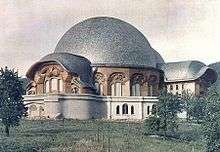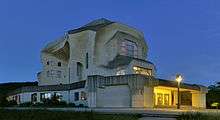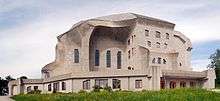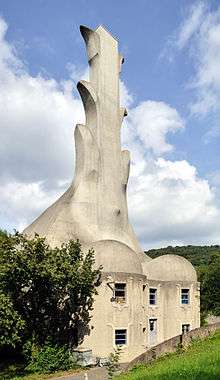Goetheanum
The Goetheanum, located in Dornach, in the canton of Solothurn, Switzerland, is the world center for the anthroposophical movement.
| Goetheanum | |
|---|---|
 | |
 Goetheanum | |
| General information | |
| Town or city | Dornach |
| Country | Switzerland |
| Coordinates | 47°29′10″N 7°37′13″E |
The building was designed by Rudolf Steiner and named after Johann Wolfgang von Goethe.[1] It includes two performance halls (1500 seats), gallery and lecture spaces, a library, a bookstore, and administrative spaces for the Anthroposophical Society; neighboring buildings house the society's research and educational facilities. Conferences focusing on themes of general interest or directed toward teachers, farmers, doctors, therapists, and other professionals are held at the center throughout the year.
Both the present Goetheanum building and its precursor have been widely cited as masterpieces of modern architecture.[2][3][4][5][6]
The Goetheanum is open for visitors seven days a week and offers tours several times daily.
| Part of a series on |
| Anthroposophy |
|---|
| General |
| Anthroposophically inspired work |
| Philosophy |
First Goetheanum

The First Goetheanum, a timber and concrete structure designed by Rudolf Steiner,[7][8] was one of seventeen buildings Steiner designed between 1908 and 1925.[9] It was intended as a Gesamtkunstwerk (the synthesis of diverse artistic media and sensory effects), infused with spiritual significance.[10] Begun in 1913 to house the annual summer theater events of the Anthroposophical Society,[11] it rapidly became the center of a small colony of spiritual seekers located in Dornach and based around Steiner.[12] Numerous visual artists contributed to the building: architects created the unusual double-dome wooden structure over a curving concrete base, stained glass windows added color into the space, painters decorated the ceiling with motifs depicting the whole of human evolution, and sculptors carved huge column bases, capitals, and architraves with images of metamorphoses.[9][13]
Already during the construction, musicians, actors, and movement artists began performing a wide variety of pieces in a neighboring workshop. When the Goetheanum hall was completed, in 1919, these performances moved onto the stage located under the Goetheanum's smaller cupola. The auditorium was located under the larger cupola. The building was opened on September 26, 1920.[14]
This building was destroyed by fire on New Year's Eve, December 31, 1922 – January 1, 1923, and some claim by arson,[13][15] but that is not proven.[14]
Second Goetheanum





In the course of 1923, Steiner designed a building to replace the original. This building, now known as the Second Goetheanum, was built wholly of cast concrete.[16] Begun in 1924, the building was not completed until 1928,[11] after the architect's death. It represents a pioneering use of visible concrete in architecture[17] and has been granted protected status as a Swiss national monument.[18] Art critic Michael Brennan has called the building a "true masterpiece of 20th-century expressionist architecture".[4]
The present Goetheanum houses a 1000-seat auditorium, now the center of an active artistic community incorporating performances of its in-house theater and eurythmy troupes as well as visiting performers from around the world. Full remodelings of the central auditorium took place in the mid-1950s and again in the late 1990s. The stained glass windows in the present building date from Steiner's time; the painted ceiling and sculptural columns are contemporary replications or reinterpretations of those in the First Goetheanum.
In a dedicated gallery, the building also houses a nine-meter-high wooden sculpture, The Representative of Humanity, by Edith Maryon and Rudolf Steiner.[19]
Architectural principles
Steiner's architecture is characterized by a liberation from traditional architectural constraints, especially through the departure from the right-angle as a basis for the building plan. For the first Goetheanum he achieved this in wood by employing boat builders to construct its rounded forms; for the second Goetheanum by using concrete to achieve sculptural shapes on an architectural scale.[20] The use of concrete to achieve organically expressive forms was an innovation for the times; in both buildings, Steiner sought to create forms that were spiritually expressive.[21]
Steiner suggested that he had derived the sculptural forms of the first Goetheanum from spiritual inspirations.[22]
Additional buildings
Steiner designed approximately 12-13 other built structures, including both institutional structures and residences in and around Dornach.[21] Steiner is one of very few major architects[23] who was never the pupil of another major architect.[24]
Architects who have visited and praised the Goetheanum's architecture include Henry van de Velde, Frank Lloyd Wright, Hans Scharoun, and Frank Gehry.[25]
References
- Sokolina, Anna P. "Biology in Architecture: the Goetheanum Case Study." In: The Routledge Companion to Biology in Art and Architecture, edited by Charissa Terranova and Meredith Tromble, 52-70. New York and London: Routledge, 2016. 546p.
- Both Goetheanum buildings are listed as among the most significant 100 buildings of modern architecture by Goulet, Patrice, Les Temps Modernes?, L'Architecture D'Aujourd'hui, December 1982
- Rudolf Steiner Archived 2015-09-24 at the Wayback Machine, Great Buildings Online
- Michael Brennan, Rudolf Steiner, artnet Magazine 3/18/98
- Hortola, Policarp. "The Aesthetics of haemotaphonomy: A study of the stylistic parallels between a science and literature and the visual arts". Eidos 2009, n.10, pp. 162-193
- Spirituelles Gemeinschaftswerk Das Erste Goetheanum in Dornach – eine Ausstellung im Schweizerischen Architekturmuseum Basel, Neue Zurcher Zeitung 10.5.2012
- Patrice Goulet, "Les Temps Modernes?", L'Architecture D'Aujourd'hui, Dec. 1982, pp. 8-17.
- Goetheanum I in The Great Buildings Collection, compiled by ArchitectureWeek. Great buildings online listing
- David Adams, "Rudolf Steiner's First Goetheanum as an Illustration of Organic Functionalism", The Journal of the Society of Architectural Historians, 51(2), 182-204, June 1992. Abstract
- Eugene Santomasso, Origins and Aims of German Expressionist Architecture: An essay into the expressionist frame of mind in Germany, especially as typified in the work of Rudolf Steiner, Ph.D. dissertation, Columbia University, 1973, AAT 7616368. Dissertation extract Archived 2007-12-14 at the Wayback Machine
- Beate Steinberg, Sculptural Architecture: Rudolf Steiner's Goetheanum at Dornach, from wood to concrete, Master's thesis, California State University, 1976, AAT 1308149.
- Anna Sokolina, ed., co-author, Architecture and Anthroposophy, "Part One: Origins", "Part Two: New Impulses", 1st and 2nd edition, M: KMK, 2001, 2010. 268p. 348 ills. 2001 ISBN 587317-0746, 2010 ISBN 587317-6604.
- Bernadette (Becky) Schwarz, A Study of Rudolf Steiner's First Goetheanum, M.A. thesis, Michigan State University, 1983.
- Paull, John (2020). The First Goetheanum: A Centenary for Organic Architecture, Journal of Fine Arts. 3 (2): 1-11
- "Home of Theosophy Burns", The New York Times, Jan 2, 1923.
- Sokolina, Anna P. "The Goetheanum Culture in Modern Architecture." [Kultura Geteanuma v sovremennoi architecture.] Science, Education and Experimental Design [Nauka, obrazovaniie i eksperimental'noie proiektirovaniie. Trudy MARKHI], edited by Shvidkovsky D.O., G.V. Yesaulov, et al., 157-159. Moscow: MARKHI, 2014. 536p.
- Dornach in German, French and Italian in the online Historical Dictionary of Switzerland.
- Hans Hasler, "A sculptural expression of harmony", Architects' Journal , S9(3), March 4, 1999.
- Paull, John (2018) A Portrait of Edith Maryon: Artist and Anthroposophist, Journal of Fine Arts, 1(2):8-15.
- Richard Reid, The book of buildings: Ancient, medieval, Renaissance & modern architecture of North America & Europe, ISBN 0-442-27805-5. Chapter title "Modern Architecture", subsection "Switzerland".
- Werner Blaser, Nature in Buildings: Rudolf Steiner in Dornach 1913-1925, ISBN 3-7643-6541-2
- Rudolf Steiner, Ways to a New Style in Architecture, five lectures given at Dornach, Switzerland during the building of the First Goetheanum, 1914. Also published as Architecture as a Synthesis of the Arts, 1999, ISBN 1-85584-057-X
- Adolf K. Placzek, editor in chief. New York: Free Press; London: Collier Macmillan, 1982. ISBN 0-02-925000-5
- Garry Stevens in "The Favored Circle", 1998, MIT ISBN 0262194082
- Reinhold Johann Fäth, Rudolf Steiner Design – Spiritueller Funktionalismus Kunst, Diss. University of Konstanz (2004) (as PDF Archived 2005-05-23 at the Wayback Machine)
External links
| Wikimedia Commons has media related to: |
- Official website
- Goetheanum 3D VRML Models by Horst Kiechle
- The First Goetheanum at the Great buildings online website
- Architecture Section at the Rudolf Steiner Archive, An Online Library
- Architecture and Anthroposophy. (Arkhitektura i Antroposofiia. bilingual ed.) Anna Sokolina, ed., co-author. 1st and 2nd edition. 268p. M.: KMK Scientific Press. 2001, ISBN 5-87317-074-6. 2010, ISBN 5-87317-660-4. Official book website.
- Ákos Moravánszky, "The Rudolf Steiner Goetheanum: An architecture report from Dornach", Domus, February 2011